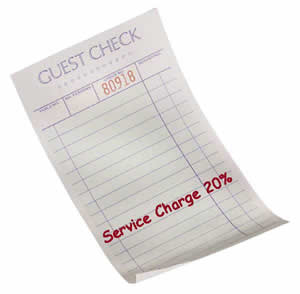Difference between Service Tax and Service Charge
Key Difference: A service tax is a tax that is levied by the government for whom certain services are provided. A service charge is an unofficial charge levied by restaurants for services provided.
 When one goes to pay the bill in a restaurant after dining there, they might notice certain charges on the bill in addition to the cost of the dish. One of these additional costs may be service tax; another may be a service charge. Many people assume them to be the same, or worse don’t even check, which is how many restaurants tend to dupe their customers. However, in reality, a service tax and a service charge are two very different things.
When one goes to pay the bill in a restaurant after dining there, they might notice certain charges on the bill in addition to the cost of the dish. One of these additional costs may be service tax; another may be a service charge. Many people assume them to be the same, or worse don’t even check, which is how many restaurants tend to dupe their customers. However, in reality, a service tax and a service charge are two very different things.
A service tax is a tax that is levied by the government for whom certain services are provided. Any service, such as a phone bill payment or hiring a room in a hotel or eating in a restaurant is taxable by the government under service tax. However, the tax is usually not applicable on the whole bill, but rather only on certain services, which make up only part of the bill. For example, in India, the service tax is currently 14%, which is only applicable on 40% of the bill. So, if the bill is Rs. 1000, then 40% of the bill would be Rs. 400, and the 14% service tax will be calculated on this Rs. 400. Hence, the service tax would actually be calculated as 5.6% on the whole bill, which is 14% on 40%.
Technically, the Service Tax is applied on the business that provide the services, and not on the customers, but a clause allows the businesses to collect the service tax from its customers, which is what they often do.
 In comparison, a service charge is a charge that is levied for the services provided. However, the service charge is not levied by the government and is not paid to the government by the business. The service charge is purely a charge by the restaurant or business on the customer, which directly goes into the business’s profit.
In comparison, a service charge is a charge that is levied for the services provided. However, the service charge is not levied by the government and is not paid to the government by the business. The service charge is purely a charge by the restaurant or business on the customer, which directly goes into the business’s profit.
Restaurants often charge a service charge for services rendered such as serving the food at the table, cleaning the table, etc. Furthermore, as there is no law regulating this, businesses charge anywhere between 5% to 20% as a service charge, which is applied on the whole bill. It is generally accepted that if a restaurant charges a customer a service charge, then the customers do not have to pay a tip. However, some restaurants expect their customers to pay both, even though they both are payment for service. Hence, an unsuspecting customer may end up a service tax, a service charge, and a tip, all in addition to the bill itself.
Comparison between Service Tax and Service Charge:
|
|
Service Tax |
Service Charge |
|
Description |
A government tax levied for services provided |
An unofficial charge levied for services provided |
|
Levied by |
Levied by the Government |
Levied by the restaurant or business |
|
Paid to |
Paid to the Government |
Not paid to the Government |
|
Applicable by |
Applicable for restaurants, eating-joints, or messes that have air-conditioning. Restaurants that do not have air-conditioning are exempt. |
Can be levied by any restaurant, eating-joints, messes, or businesses. |
|
Applicable on |
Applicable on only certain parts of the bill, not the whole bill. |
Can be and usually is applicable on the whole bill. |
Image Courtesy: moneycontrol.com, blog.abbeyspanier.com









Comments
Anonymous
Mon, 12/14/2015 - 20:56
Correction made, thanks :)
dbadmin
Tue, 12/15/2015 - 17:41
Add new comment